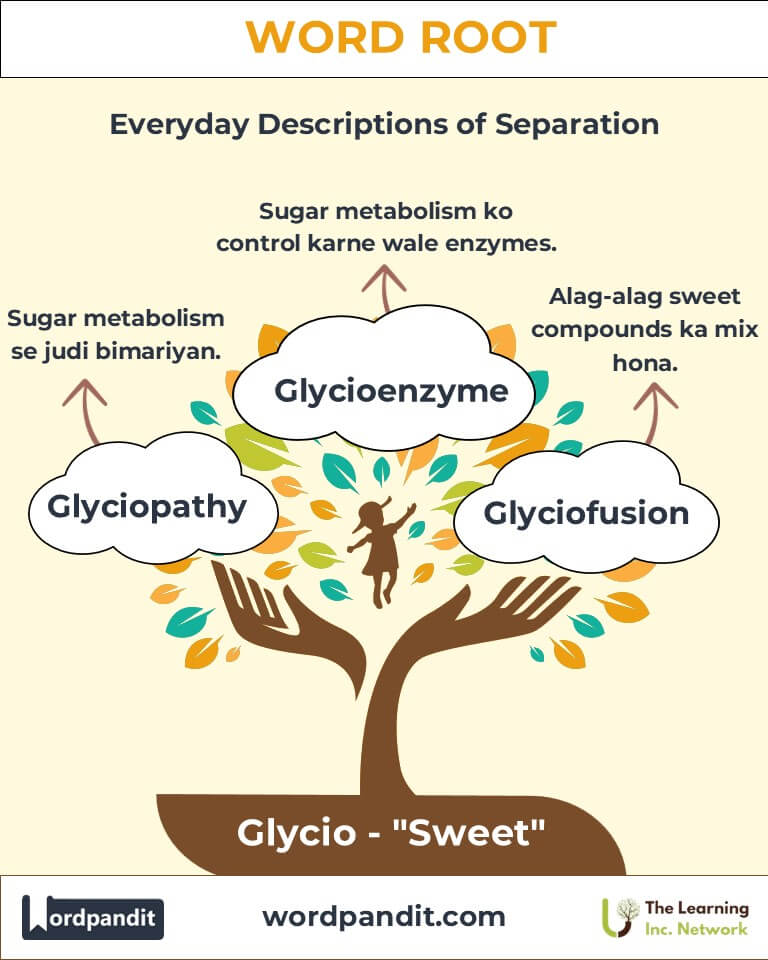Glycio: The Sweetness Root in Language and Science
Discover the linguistic richness of the root "glycio," derived from Greek, meaning "sweetness." From specialized terms like "glyciogeusia" to whimsical concepts like "glyciophilia," this root embodies the charm and complexity of sweetness across disciplines, cultures, and language.

Table of Contents
- Introduction: The Sweet Essence of Glycio
- Etymology and Historical Journey
- Mnemonic: Unlocking the Power of Glycio
- Common Glycio-Related Terms
- Glycio Through Time
- Glycio in Specialized Fields
- Illustrative Story: Glycio in Action
- Cultural Significance of Glycio
- The Glycio Family Tree
- FAQs about the Glycio Root
- Test Your Knowledge: Glycio Mastery Quiz
- Conclusion: The Living Legacy of Glycio
1. Introduction: The Sweet Essence of Glycio
Imagine a world without sweetness, where the joy of tasting your favorite dessert or experiencing a heartwarming moment is absent. The root "glycio" (pronounced "glai-see-oh") captures the essence of sweetness, both literal and metaphorical. Originating from Greek, this root forms the foundation of words that describe the presence, perception, and love of sweetness. Glycio is not only a linguistic delight but also a vital concept in fields such as medicine, gastronomy, and psychology.

2. Etymology and Historical Journey
The root "glycio" stems from the Greek word glykys, meaning "sweet." Ancient Greek scholars used it to describe sensory and chemical experiences related to sweetness. Over time, glycio has found its way into modern scientific nomenclature, particularly in biology and chemistry, where it is used to describe sugar-related phenomena and structures.
3. Mnemonic: Unlocking the Power of Glycio
Picture a luscious honeycomb dripping with golden nectar labeled "Glycio." This image connects the root's meaning to its literal essence: sweetness.
Mnemonic Device: “Glycio glows with the golden sweetness of life.”
4. Common Glycio-Related Terms
- Glyciogeusia (glai-see-oh-goo-see-uh): The perception of sweetness in the mouth.
Example: After eating the fruit, her glyciogeusia heightened, making everything taste sweeter. - Glyciophilia (glai-see-oh-fil-ee-uh): A love or fondness for sweet things.
Example: His glyciophilia was evident in his endless collection of dessert recipes. - Glycogenesis (glai-koh-jen-uh-sis): The process of forming glycogen from glucose.
Example: During rest, the body engages in glycogenesis to store energy. - Glycolysis (glai-koh-lih-sis): The metabolic breakdown of glucose to release energy.
Example: Glycolysis is a critical process for energy production in cells. - Glycemic (glai-see-mik): Relating to the sugar content in blood.
Example: Monitoring glycemic levels is essential for managing diabetes.
5. Glycio Through Time
- Ancient Roots: The term "glyco-" was first used in early Greek medicine to describe sweetness in bodily fluids.
- Modern Science: In the 19th century, with the discovery of glucose, "glyco-" became a staple in scientific terminology, expanding into disciplines like endocrinology and nutrition.
6. Glycio in Specialized Fields
- Medicine:
- Glycemic Index: A measure of how quickly foods raise blood sugar levels.
- Relevance: Essential for diabetes management and dietary planning.
- Biology:
- Glycoproteins: Proteins with sugar molecules attached.
- Application: Important in cell signaling and immune responses.
- Psychology:
- Glyciophilia: Symbolizes emotional sweetness or affinity for positive experiences.
- Use: Explored in studies of reward systems and sensory preferences.
- Food Science:
- Glyciogeusia: Studying taste profiles in food development.
- Impact: Shapes the creation of artificial sweeteners and flavor enhancers.
7. Illustrative Story: Glycio in Action
Maya, a renowned pastry chef, faced a challenge: creating a dessert that embodied "sweetness" without relying on traditional sugars. Drawing inspiration from her knowledge of glyciogeusia, she experimented with natural sweeteners and flavor compounds. The result was a masterpiece that delighted the palate while staying health-conscious, proving the boundless potential of glycio-inspired innovation.
8. Cultural Significance of Glycio
Sweetness transcends cultures as a universal symbol of joy, celebration, and comfort. From honey in ancient rituals to modern confectionery, glycio reflects humanity’s timeless affection for the sweet side of life. Festivals like Diwali and Christmas highlight the role of sweetness in fostering connection and happiness.

9. The Glycio Family Tree
- Saccharo- (Greek: "sugar"):
- Saccharine: Excessively sweet.
Example: Her saccharine tone masked genuine intentions.
- Saccharine: Excessively sweet.
- Dulci- (Latin: "sweet"):
- Dulcet: Pleasant and sweet-sounding.
Example: The dulcet tones of her voice were mesmerizing.
- Dulcet: Pleasant and sweet-sounding.
- Mell- (Latin: "honey"):
- Mellifluous: Flowing sweetly, like honey.
Example: The mellifluous melody enchanted the audience.
- Mellifluous: Flowing sweetly, like honey.

10. FAQs About " Glycio "
Q: What does "glycio" mean?
A: "Glycio" means "sweetness" and is derived from the Greek word glykys. This root is used to describe anything related to sweetness, whether literal (like sugar) or metaphorical (like pleasant experiences).
Q: How is "glycio" used in medicine?
A: In medicine, "glycio" forms part of terms like "glycemic index," which measures how foods impact blood sugar levels, and "glycogenesis," which describes the process of converting glucose into glycogen for storage. These concepts are vital in managing conditions like diabetes and understanding energy storage.
Q: What is glyciogeusia?
A: Glyciogeusia refers to the perception of sweetness in the mouth. It describes how the taste buds on our tongue detect sweet flavors, and it plays a key role in our enjoyment of food and beverages.
Q: What is glyciophilia?
A: Glyciophilia denotes a love or fondness for sweet things. This term can describe a preference for sugary treats or even a metaphorical sweetness, such as a love for pleasant and delightful experiences.
Q: What does "glycogenesis" mean?
A: Glycogenesis is the biological process of forming glycogen from glucose. This happens in the liver and muscles to store energy for future use, especially during physical activity or fasting periods.
11. Test Your Knowledge: " Glycio " Mastery Quiz
1. What does "glycio" mean?
2. What is glyciogeusia?
3. What does the glycemic index measure?
4. Which term describes a love for sweet things?
5. What does "glycogenesis" describe?
12. Conclusion: The Living Legacy of Glycio
The root "glycio" reminds us of the fundamental sweetness that enriches both life and language. From scientific breakthroughs to cultural traditions, glycio continues to sweeten our understanding of the world. As we explore its applications, we uncover new ways to appreciate and celebrate the joys of sweetness.












